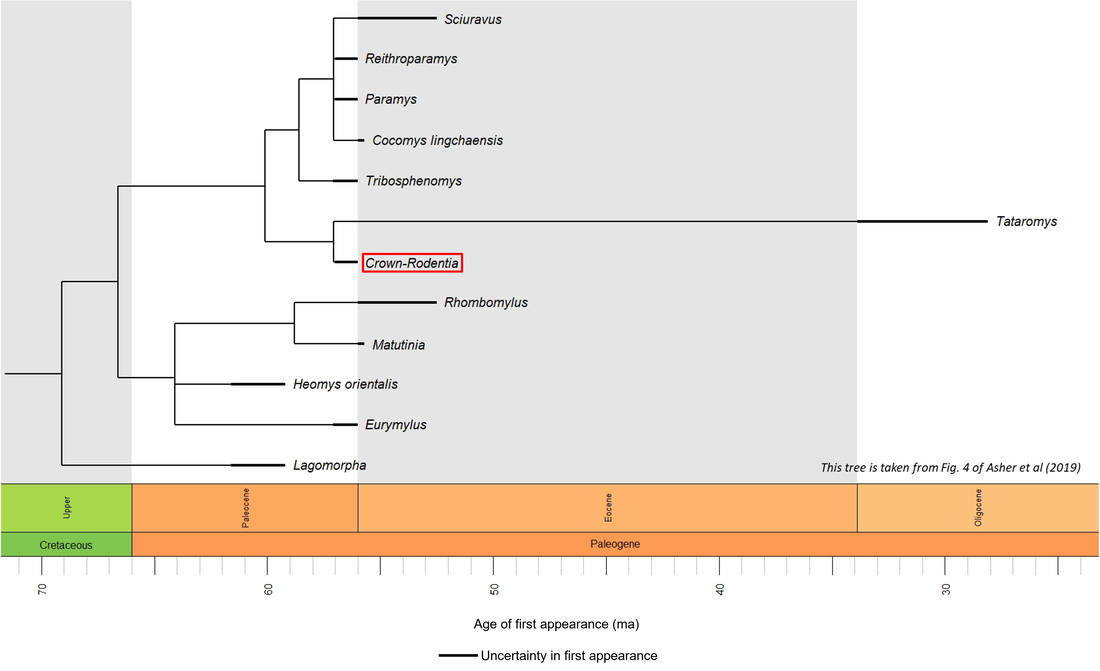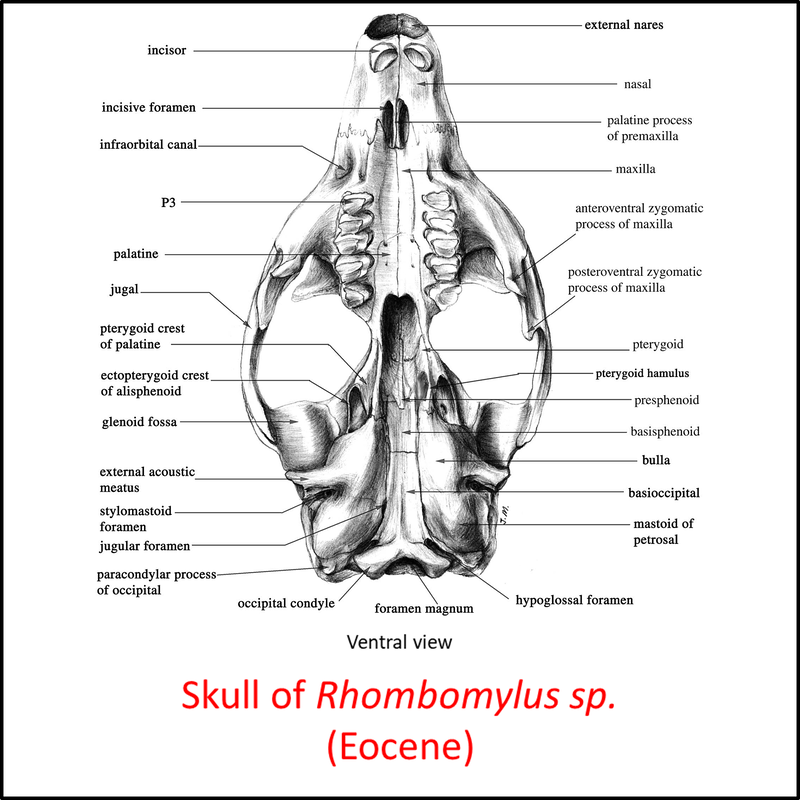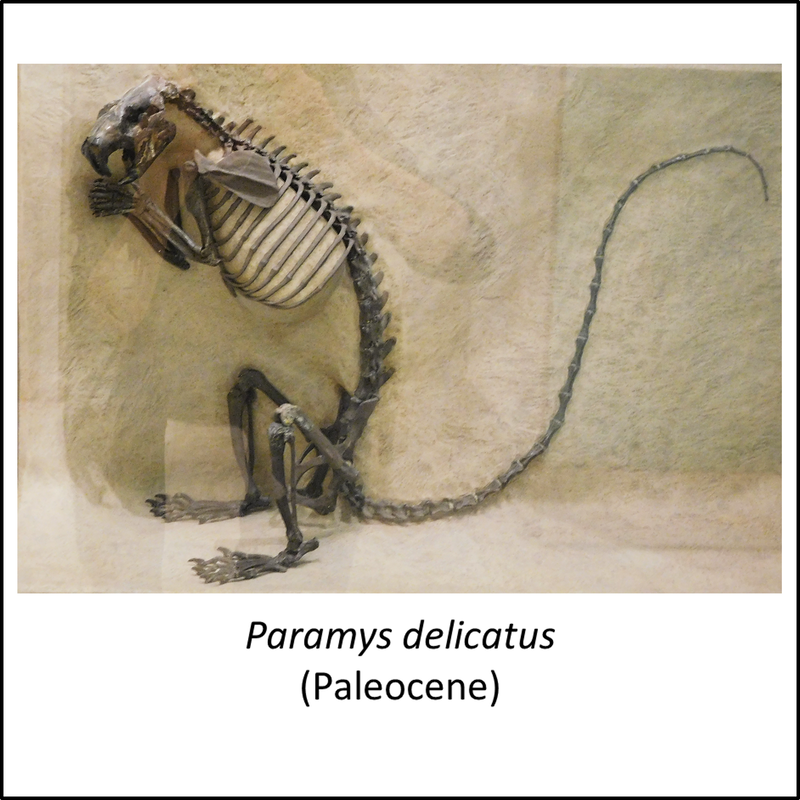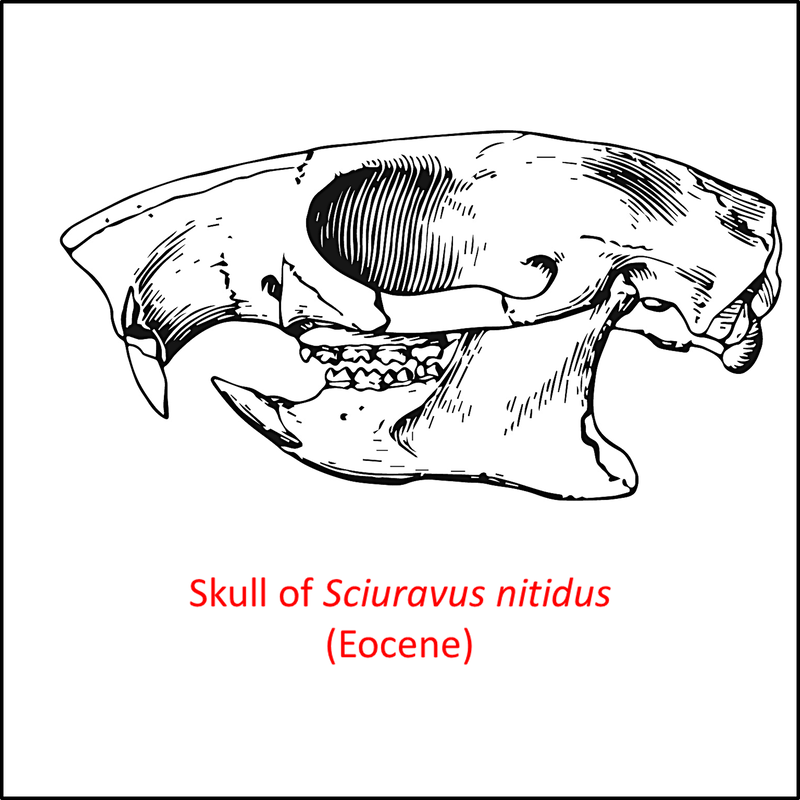The rodents (order Rodentia, infraclass Eutheria) are characterized by upper and lower pairs of ever-growing rootless incisor teeth (Encyclopaedia Britannica). They form a clade that has been subdivided into four suborders:
Very few phylogenetic studies of the stem rodents have been published. A recent example is that of Asher et al (2019), on which the following time tree is based:
- Hystricomorpha (includes porcupines and guinea pigs)
- Sciuromorpha (includes squirrels)
- Castorimorpha (includes beavers)
- Myomorpha (includes mice, rats and hamsters)
Very few phylogenetic studies of the stem rodents have been published. A recent example is that of Asher et al (2019), on which the following time tree is based:
Figure 1. Time tree of the stem-Rodentia
The oldest known member of the stem-Rodentia is Heomys orientalis, described from the Middle Paleocene upper member of the Doumu Formation at Qianshan locality 71017 in Anhui Province, China (Li, 1977). Unfortunately, no images are available in the public domain either for this species or for most of the other members of the stem group. The few that are available are shown below:
Names in red indicate that the fossil is younger than the oldest known crown-group fossil.
Figure 2. Images of stem-Rodentia
Obviously, no trends can be discerned with such a limited set of images.
The oldest known crown rodent is Acritoparamys atavus, described from Clarkforkian (Late Paleocene) sediments in the Eagle Coal Mine near Bear Creek, Carbon County, Montana, USA (Ivy, 1990; Foley et al, 2016). Again, no public-domain images are available.
The available fossil data indicate that the rodent stem group developed from Middle Paleocene to Late Paleocene time, representing a minimum stem-to-crown transition period of only 2.2 million years.
The oldest known crown rodent is Acritoparamys atavus, described from Clarkforkian (Late Paleocene) sediments in the Eagle Coal Mine near Bear Creek, Carbon County, Montana, USA (Ivy, 1990; Foley et al, 2016). Again, no public-domain images are available.
The available fossil data indicate that the rodent stem group developed from Middle Paleocene to Late Paleocene time, representing a minimum stem-to-crown transition period of only 2.2 million years.
References
Asher, R. J., Smith, M. R., Rankin, A., & Emry, R. J. (2019). Congruence, fossils and the evolutionary tree of rodents and lagomorphs. Royal Society open science, 6(7), 190387.
Flynn, L. J., Jacobs, L. L., Kimura, Y. U. R. I., & Lindsay, E. H. (2019). Rodent suborders. Fossil Imprint, 75(3-4), 292-298.
Foley, N. M., Springer, M. S., & Teeling, E. C. (2016). Mammal madness: is the mammal tree of life not yet resolved? Philosophical Transactions of the Royal Society B: Biological Sciences, 371(1699), 20150140.
Glanz, W. E., & Anderson, S. (1990). Notes on Bolivian mammals. 7, A new species of Abrocoma (Rodentia) and relationships of the Abrocomidae. American Museum Novitates; no. 2991.
Ivy, L. D. (1990). Systematics of late Paleocene and early Eocene Rodentia (Mammalia) from the Clarks Fork Basin, Wyoming. Contributions from the Museum of Paleontology, U. of Michigan, 28(2), 21-70.
Li, C. (1977). Paleocene eurymyloids (Anagalida, Mammalia) of Qianshan Anhui. Vertebrata PalAsiatica, 15, 103-118.
Flynn, L. J., Jacobs, L. L., Kimura, Y. U. R. I., & Lindsay, E. H. (2019). Rodent suborders. Fossil Imprint, 75(3-4), 292-298.
Foley, N. M., Springer, M. S., & Teeling, E. C. (2016). Mammal madness: is the mammal tree of life not yet resolved? Philosophical Transactions of the Royal Society B: Biological Sciences, 371(1699), 20150140.
Glanz, W. E., & Anderson, S. (1990). Notes on Bolivian mammals. 7, A new species of Abrocoma (Rodentia) and relationships of the Abrocomidae. American Museum Novitates; no. 2991.
Ivy, L. D. (1990). Systematics of late Paleocene and early Eocene Rodentia (Mammalia) from the Clarks Fork Basin, Wyoming. Contributions from the Museum of Paleontology, U. of Michigan, 28(2), 21-70.
Li, C. (1977). Paleocene eurymyloids (Anagalida, Mammalia) of Qianshan Anhui. Vertebrata PalAsiatica, 15, 103-118.
Image credits – stem-Rodentia
- Header (Red Squirrel, Sciurus vulgaris, Parc de Woluwé, Brussels, Belgium): Frank Vassen from Brussels, Belgium, CC BY 2.0 <https://creativecommons.org/licenses/by/2.0>, via Wikimedia Commons
- Figure 2 (Rhombomylus sp.): Licensed from MENG, JIN, HU, YAOMING, LI, CHUANKUI (2003): The Osteology Of Rhombomylus (Mammalia, Glires): Implications For Phylogeny And Evolution Of Glires. Bulletin of the American Museum of Natural History 2003 (275): 1-247, under Creative Commons Attribution 4.0 International.
- Figure 2 (Paramys delicatus): Rique, CC BY-SA 4.0 <https://creativecommons.org/licenses/by-sa/4.0>, via Wikimedia Commons
- Figure 2 (Sciuravus nitidus): Open Access article Adams, N. F., Rayfield, E. J., Cox, P. G., Cobb, S. N., & Corfe, I. J. (2019). Functional tests of the competitive exclusion hypothesis for multituberculate extinction. Royal Society Open Science, 6(3), 181536.



